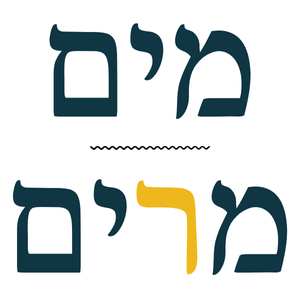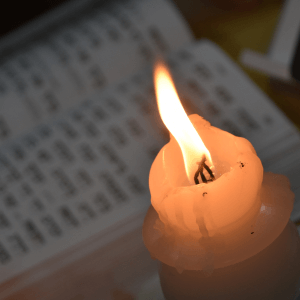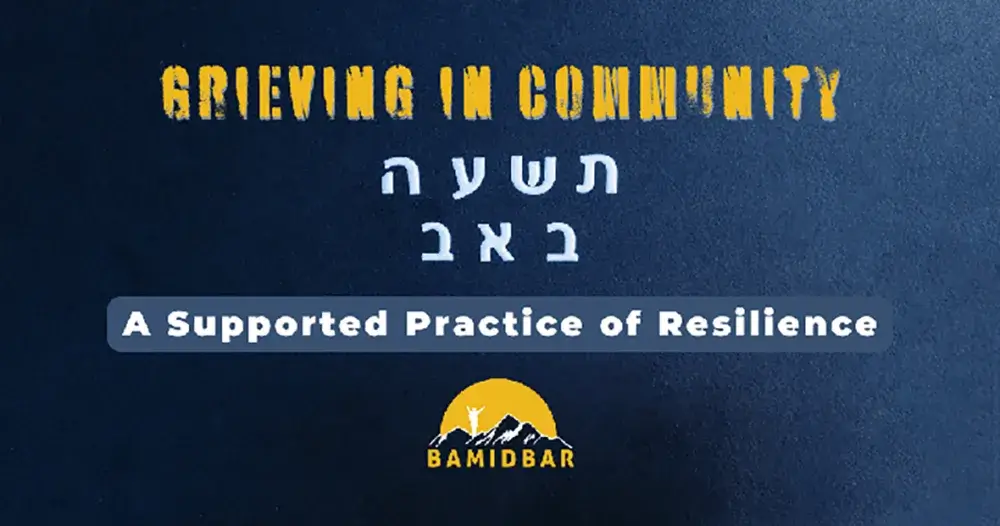By Rabbi Batya Elana Ellinoy
 Many spiritual teachers of various wisdom traditions, contemporary scholars, and psychologists emphasize the necessity for the processing of grief as fundamental to our individual and collective well-being.
Many spiritual teachers of various wisdom traditions, contemporary scholars, and psychologists emphasize the necessity for the processing of grief as fundamental to our individual and collective well-being.
Grief can be defined as a natural response to loss. Grief theorist and author Dr. Kenneth Doka explains, “We can experience grief obviously when someone we’re attached to dies, but we can also experience it when we lose any significant form of attachment.” Engaging in ongoing habits of acknowledging and honoring grief is vital in the healthy development of a sustainable humanity, along with supporting our capacity to live in harmony with one another and our planet.
In the spiral of Jewish sacred time, we find ourselves in a season devoted to intentional space for communal grief practices. The Jewish calendar holds us as we gradually make our way toward the pinnacle of this time on the 9th of the Hebrew month of Av, or Tisha b’Av.
Tisha b’Av is a fast day in which we recognize Jewish collective grief, acknowledging tragic losses of security and devastating heartbreaks over the last 2000 years in Jewish history. In the three weeks leading up to that day of acute grief, beginning on the 17th of the previous month of Tammuz, Jews traditionally enter into a period of mourning known as Bein HaMeitzarim, or “Between the Narrow Spaces.”
This kind of gradual preparation of easing into grief could be seen as reflecting an approach to working with grief that cares for our mental, emotional, and spiritual well-being, and promotes resilience.
We might even see this orientation beginning before the 17th of Tammuz when we read the parasha (Torah portion) of Chukat, a parasha that reminds us of the healing power of communal grief, and also what happened when there was not space for it.
In Chukat, Miriam and Aaron, two prominent figures who have played principal roles in the Israelites’ 40-year journey through the wilderness, both die. The Israelite community responds very differently to each of their deaths.
Immediately after Miriam’s death, the Torah relays that the community is without water, and the Israelites gather against Moses and Aaron. The Israelites launch into their typical complaining and fighting, but this round seems worse and more hostile than usual. They ask why they have been brought out of Egypt to this horrible place, hamakom hara.
In seeking how to best respond in such a crisis, Moses and Aaron go to God, falling on their faces. Perhaps this organic choreography reflects their own internal “horrible place” of being in anguish, an emotion that, according to author Brené Brown, can literally take us to our knees.
God instructs Moses to respond to the people by taking his staff, gathering the community, and together with Aaron, speak to a rock so that it will give its water.
When Moses and Aaron return to gather the people at the rock, instead of following God’s instructions, Moses does use his voice, but not by speaking to the rock. Rather, he chastises the Israelites saying, “Listen up you rebels!” Or, more literally:
“You bitter people! Let’s see if this rock can bring forth water for you all!”
And then, Moses hits the rock.
Copious water comes out and the communal water crisis seemingly concludes. However, God then tells Moses and Aaron that because they did not embody their faithfulness in God and reflect the holiness of the Divine to the children of Israel through their actions, Moses and Aaron will not go into the Promised Land.
On the surface, this can certainly seem like punishment for Moses and Aaron, and it is often interpreted that way. But in taking a deeper look into what may be going on in the hearts and minds of these leaders as well as those of the entire Israelite community, we might come to a different interpretation: What was missing here was space and time for communal grief.
Many commentators throughout the ages, including today, focus on Moses’ anger and rage in this incident as the reason he is not allowed into the Promised Land.
In modern-day psychology, anger is often referred to as a “secondary emotion.” This means that anger can sometimes be secondary to a primary emotion that may get bypassed and overlooked. Primary emotions that may come before anger include but are not limited to sadness, fear, helplessness, or grief.
Anger may be secondary to these and other emotions perhaps because the intensity of anger can even be experienced internally as a form of protection from feeling the possible “horrible places” of discomfort that many of these and other primary emotions bring.
Might it be possible then, that the entire community, including Moses and Aaron, were all in such deep sorrow at the loss of Miriam but unable to acknowledge, allow, and honor this pain, that their collective grief for Miriam came out sideways?
Illustrations of this “sideways grief” include the Israelites ganging up on Moses and Aaron, their painful cutting remarks and complaints, the lack of compassion shown in how Moses responded to the community, and how Moses hit the rock.
There is a midrash, or rabbinic narrative, that teaches that by Miriam’s merit, there was a well following the Israelites throughout their 40 years in the desert as their source of water. According to the midrash, when Miriam died, the well dried up. This is how powerfully the rabbinic imagination might have understood the impact of Miriam’s death on the community; they lost connection and contact with what they had known to be a life-sustaining source.
In the text of the Torah itself, there is no overt mention of how the community is navigating their grief for Miriam. However, upon closer investigation, we might see how the Torah may be hinting that this loss is more present with them than even the Israelites may be conscious.

As one possibility, the Hebrew letters that spell water (mayyim) and Miriam’s name are almost identical, yet for water there’s one letter missing, the reysh (ר):
When, immediately after Miriam’s burial, the next verse reads, “There was no water for the community”, the loss of the letter reysh is almost as if it could be a scribal error or an omission of awareness in the Israelites’ consciousness that “There was no Miriam for the community.”
Without this awareness, they are confusing the loss of Miriam with mayyim (water) because they’ve been unable to feel and grieve Miriam’s death.
They have yet to actually acknowledge their well of grief.
Another way the text hints at unprocessed grief is when Moses chastises the Israelites – he calls them “HaMarim.” With different Hebrew vowels, “Marim” is the exact same spelling as Miriam. It is as if Moses is crying out, in grievous disorientation,
“Please everyone, Listen! – Miriam?! [Where are you?!] Let’s see if this rock can bring forth Miriam for you all!?!”
What if, due to the immense unprocessed grief, Moses has lost his bearings and cannot “lead straight” in this moment? His cutting words back to the people, his lack of access to empathy for those who have also just lost someone dear to them, and his failure to listen to and follow God’s instructions (Moses’s most reliable and consistent superpower) could also be recognized as misdirected grief.
In contrast with another death later in this same Torah portion, when we also lose Aaron; the Torah relays that when the community sees and understands that Aaron had died, they cry, they bewail, and they mourn the loss of him for thirty days. Kol Beit Israel: The entire community of Israel engages in this mourning.
 Does another water crisis ensue? A dried-up disconnect from a life-source? No. The Israelites have allowed their tears to flow. They do continue their pattern of complaining, but not to the same extent. The complaining recurs only when they take up to leave where Aaron is buried. It would make sense that there could be a flare up of a sideways expression of grief at that time of transition on their journey. However, what is especially remarkable is that they are much quicker to do teshuva (repent) after that complaining episode, to acknowledge that they went astray in not feeling their connection to God, and seek to return themselves to this connection with help from Moses. This is a heartening sign of their growth and resilience, a sign that their engagement in the collective grief process provided them with this capacity and strength.
Does another water crisis ensue? A dried-up disconnect from a life-source? No. The Israelites have allowed their tears to flow. They do continue their pattern of complaining, but not to the same extent. The complaining recurs only when they take up to leave where Aaron is buried. It would make sense that there could be a flare up of a sideways expression of grief at that time of transition on their journey. However, what is especially remarkable is that they are much quicker to do teshuva (repent) after that complaining episode, to acknowledge that they went astray in not feeling their connection to God, and seek to return themselves to this connection with help from Moses. This is a heartening sign of their growth and resilience, a sign that their engagement in the collective grief process provided them with this capacity and strength.
Every year when we read this parasha at the beginning of the month of Tammuz, we are encouraged to look to the experiences and the learning of the Israelites for inspiration, hope, strength, and faith. Faith that when we are supported to feel, be in, and tend our grief, all together, kol beit yisrael, this actually brings us more life. Torah, our Tree of Life, teaches us how allowing grief to move through us is an expression of maintaining faith in God, the Source of All Life. Moreover, Torah also reminds us that grieving in community propels us toward teshuva, returning to our truest and evolving aliveness with an enhanced sense of interconnectedness and belonging.
Most importantly, we are not meant to be alone in our grief. Whether we are going through a wave or supporting another as they ride their own, we are meant to share our grief in community.
This is the wisdom that Torah offers as a gateway into this season: As part of the recipe for living, there needs to be time for grieving. Though we may be tempted to avoid the pain or we may fear being overwhelmed by it, grieving is truly part of what makes us human. To grieve is a practice of choosing life. Engaging in sacred communal rituals to digest and integrate grief is to both mourn for those we have lost as well as honor ourselves and our communities.
Most importantly, we are not meant to be alone in our grief. Whether we are going through a wave or supporting another as they ride their own, we are meant to share our grief in community.
Over the past few months, I have been attending a bereavement group for people who are grieving the loss of a parent following the recent loss of my own father. Showing up to process and grieve a parent’s death can be especially challenging. At the same time, it has been profoundly beneficial not to be alone, to listen to others, to witness how we are all different in how we experience and process grief, and to be heard and held in mine.
A few months ago, with this parasha nowhere in my mind, I told the participants and the facilitator that being in this group is like residing in Miriam’s well: Healing, life-giving, supporting the process of grief, and returning me to discover renewed relationships with beloved ones who have passed and with those who are still alive.
This particular year leading up to Tisha B’Av has been particularly painful and difficult on so many levels. Now and always, may we be blessed to find, see, and feel held by one another as this season and our wise tradition hold us to provide us with inspiration, hope, strength, and faith. Let us recognize that we already have the impulses within us to care for and support each other as we move through life’s moments of grief to praise, contraction to expansion, darkness to light, oppression to freedom, tears to teshuva.
Kol beit yisrael.
May we know that, even in our grief, we are here together, wishing each other well.
Rabbi Batya Elana Ellinoy is the Rabbi-in-Residence at BaMidbar.

